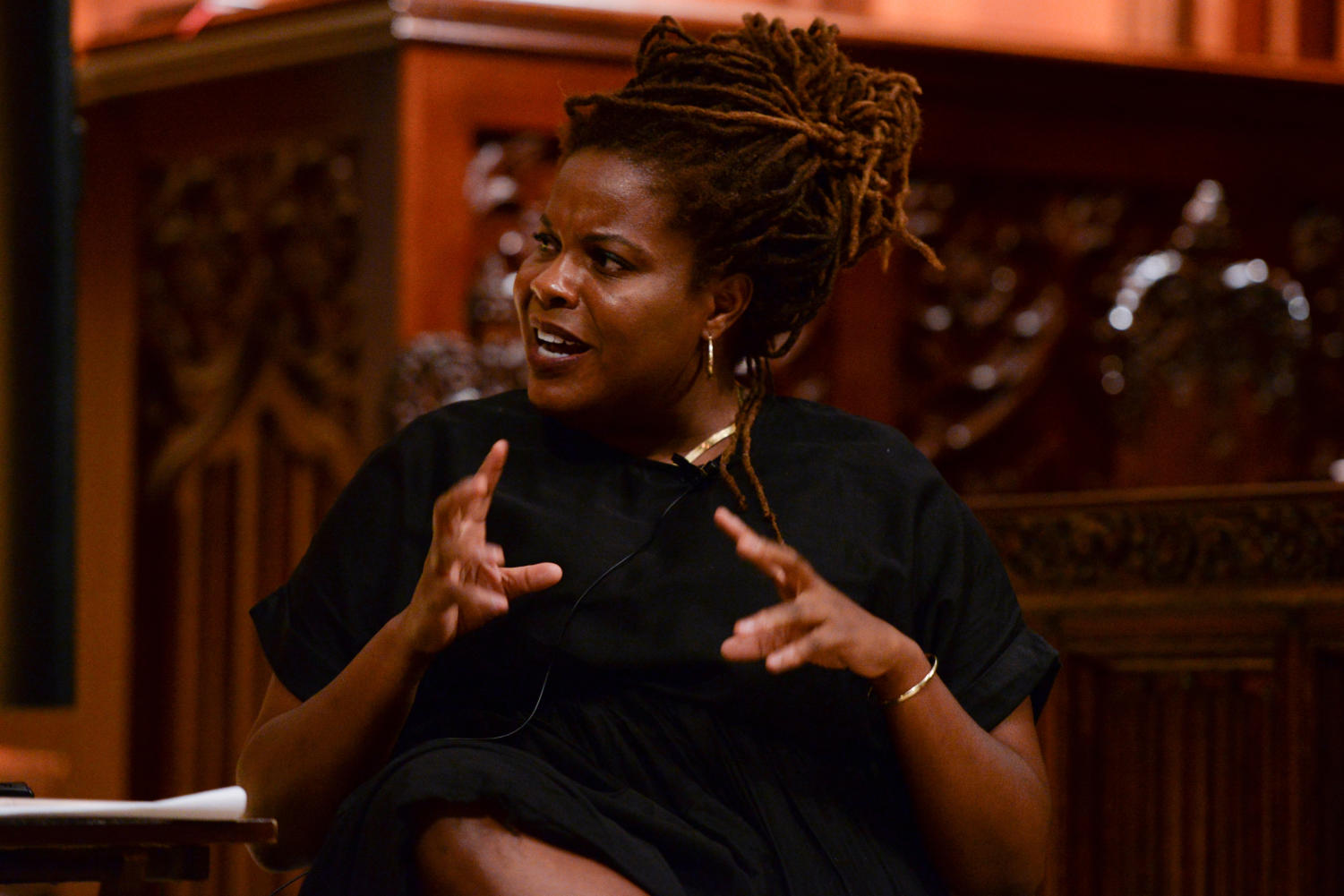Rachel Kaadzi Ghansah speaks at Heinz Chapel


Pulitzer Prize-winner Rachel Kaadzi Ghansah speaks Wednesday evening at Heinz Chapel about the omission of black writers’ creative works throughout history. (Photo by David Donlick | Staff Photographer)
Pulitzer Prize-winner Rachel Kaadzi Ghansah may have already achieved fame, but she’s still writing against erasure.
“We, black writers, writers from marginalized identities … are not just doing creative work, but trying to correct for the omission of our creative work for centuries,” she said to a crowded Heinz Chapel Wednesday night.
Ghansah, whose work has appeared in GQ, The Paris Review, The Believer and The New York Times Magazine, was this year’s first speaker in Pitt’s Contemporary Writers Series.
She won the 2018 Pulitzer Prize for Feature Writing for her GQ profile, “A Most American Terrorist: The Making of Dylann Roof,” and received awards for a profile of comedian Dave Chappelle and a piece on James Baldwin’s home in France.
And on Wednesday, she read a piece titled “From the Cradle to the Grave: A Woman’s Work” on her journey to the unmarked grave of Matilde Basquiat, the mother of the late neo-expressionist artist Jean-Michel Basquiat.
“Matilde, did you learn, like we all do, that no one builds monuments to black women unless we do it ourselves?” Ghansah said from the Heinz Chapel pulpit.
According to Ghansah, Matilde took Jean-Michel to art museums, taught him Spanish, enrolled him in art classes and gave him a copy of Gray’s Anatomy after a car hit him when he was 7 years old.
“She gave him, then, an understanding of his bones,” Ghansah said.
In the piece, she also criticized society’s tendency to memorialize black women through their relationships to men that they “nursed, birthed or loved.”
“All black women are engaged in a mothering that extends beyond the biological act,” Ghansah said.
She described a time her mother saw a friend in distress in the supermarket and walked with that friend until she was ready to leave.
“Did I not recognize that this was mothering? That this was a woman’s work?” Ghansah said.
Ghansah’s work, in comparison, is to translate those experiences into the written word — to connect with readers across different, and sometimes factious, histories and cultures. In her own words, Ghansah writes to tell the stories of the women whose work didn’t allow them to write their own.
“My grandmother was the whole world in elastic-waisted pants,” Ghansah said. “What puts me at my desk is that I don’t know if someone would write her story if I didn’t.”
She approaches her writing with tactics similar to the visual artists she’s profiled. She lays the whole draft of piece she’s working on on the floor of her home and moves it around as she finishes it.
“I’m actually working the text,” she said, motioning with her arms.
She compared the process to becoming a figurative god and turning chaos into order. She undertakes the effort because she was disappointed by black-figure profiles she read prior to writing her own.
“I would pick up profiles and they were so two-dimensional,” Ghansah said. “I hoped I would never read another awful profile of a black person again.”
So she set out to establish a higher standard of research, writing and storytelling for her subjects. She cited a interview with Lil Wayne, in which she asked him about what his life was like after he began working at 8 years old.
“He never got to have a childhood,” Ghansah said. She said that while others may look down on Lil Wayne’s syrup-drinking, she saw a child laborer.
She endeavored to apply that same depth of research and insight to all her profile subjects.
“I could become the benchmark,” Ghansah said.
According to attendees, she has.
“She’s just a black queen,” Tamara Solange Das, a senior English major, said.
Das asked Ghansah how to navigate what James Baldwin referred to as “a constant state of rage” during the Q&A portion of the event.
A class earlier in the week prompted Das’ question, when she began crying while discussing Ghansah’s Pulitzer-winning piece on the trial of white supremacist Dylann Roof. After class, Das said a white classmate approached her.
“I’ve been crying a lot too. My boyfriend broke up with me,” the classmate said to her, according to Das.
“He tried to equate his own personal experience with black pain,” Das said.
Ghansah responded to Das’ question on by telling Das to take care of herself emotionally.
“Your duty is to be your own shepherd,” Ghansah told her.
Dawn Lundy Martin, the director of Pitt’s Center for African American Poetry and Poetics, praised Ghansah’s broad range of style.
“When she writes about Kendrick Lamar, it’s very different than when she writes about Toni Morrison,” Martin said. “There’s a sheer range of imagination and intellect.”
But amidst her fame, Ghansah remains dedicated to honoring her matriarchal influences.
“I come from women … who had art in them,” Ghansah said. “[I write] with the ancestral memory of all the women who weren’t able to do that art.”
Recent Posts
Porch roof collapse injures dozens during party on Semple Street
The roof of a porch on Semple Street collapsed during a St. Patrick’s Day celebration…
A Good Hill to Die On // Break It Down
In this release of “A Good Hill to Die On,” I dive deep into the…
Who Asked? // Does growth only “count” if it’s quantifiable?
This installment of Who Asked? by staff writer Brynn Murawski wonders why it feels like…
“They’re throwing trans people under the bus”: Counseling center faces backlash after event name change
On Feb. 24, Pitt’s Counseling Center faced backlash after briefly renaming an event from "LGBT…
Q&A: Meet the 2024-2025 SGB president and vice president
SGB announced the 2024-2025 election results at their meeting on Tuesday. The Pitt News spoke…
Editorial | Pitt Administration must listen to its students’ electoral demands
The passing of these referendums does not guarantee a future Pitt with these policies. Merely,…

